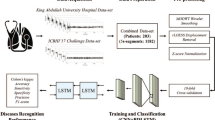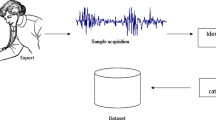Abstract
Respiratory sounds disclose significant information regarding the lungs of patients. Numerous methods are developed for analyzing the lung sounds. However, clinical approaches require qualified pulmonologists to diagnose such kind of signals appropriately and are also time consuming. Hence, an efficient Fractional Water Cycle Swarm Optimizer-based Deep Residual Network (Fr-WCSO-based DRN) is developed in this research for detecting the pulmonary abnormalities using respiratory sounds signals. The proposed Fr-WCSO is newly designed by the incorporation of Fractional Calculus (FC) and Water Cycle Swarm Optimizer WCSO. Meanwhile, WCSO is the combination of Water Cycle Algorithm (WCA) with Competitive Swarm Optimizer (CSO). The respiratory input sound signals are pre-processed and the important features needed for the further processing are effectively extracted. With the extracted features, data augmentation is carried out for minimizing the over fitting issues for improving the overall detection performance. Once data augmentation is done, feature selection is performed using proposed Fr-WCSO algorithm. Finally, pulmonary abnormality detection is performed using DRN where the training procedure of DRN is performed using the developed Fr-WCSO algorithm. The developed method achieved superior performance by considering the evaluation measures, namely True Positive Rate (TPR), True Negative Rate (TNR) and testing accuracy with the values of 0.963, 0.932, and 0.948, respectively. Moreover, the testing accuracy value achieved by the Random Forest classifier, machine learning, DNN, CNN, WCSO-based HAN, and developed Fr-WCSO-based DRN is 0.753, 0.797, 0.844, 0.887, 0.929, and 0.948. While analyzing the results that are tabulated, it is clear that the developed Fr-WCSO-based DRN computed a higher TPR of 0.963, higher TNR of 0.932 using dataset-1, and higher testing accuracy of 0.948 using dataset-2, respectively. The effectual results are obtained as the model is well trained with the proposed Fr-WCSO and hence increasing the learning rate of the Deep Residual Network.













Similar content being viewed by others
Data Availability Statement
Availability of data and materials The datasets used and/or analyzed during the current study are available from the Respiratory Sound Database, "https://www.kaggle.com/vbookshelf/respiratory-sound-database", accessed on January 2021 and International Conference in Biomedical and Health Informatics (ICBHI), ICBHI 2017 challenge database, “https://bhichallenge.med.auth.gr/”, accessed on June 2021.on reasonable request. The codes of models are available at https://github.com/Jawad-Dar/Fractional-Water-Cycle-Swarm-Optimizer-based-deep-residual-network-for-Recognition-of-lung-abnormali.
References
Sovijarvi AR. Characteristics of breath sounds and adventitious respiratory sounds. Eur Respir Rev. 2000;10:591–6.
Shuvo SB, Ali SN, Swapnil SI, Hasan T, Bhuiyan MIH. A lightweight CNN model for detecting respiratory diseases from lung auscultation sounds using emd-cwt-based hybrid scalogram. IEEE J Biomed Health Inf. 2020.
Lee SJ, Kim SW, Kong KA, Ryu YJ, Lee JH, Chang JH. Risk factors for chronic obstructive pulmonary disease among never-smokers in Korea. Int J Chron Obstruct Pulmon Dis. 2015;10:497.
Koul PA. Chronic obstructive pulmonary disease: Indian guidelines and the road ahead. Lung India, 2013;30(3):175–7.
Sarkar M, Madabhavi I, Niranjan N, Dogra M. Auscultation of the respiratory system. Ann Thorac Med. 2015;10(3):158.
Yadav A, Dutta MK, Prinosil J. Machine learning based automatic classification of respiratory signals using wavelet transform. In: 2020 43rd International conference on telecommunications and signal processing (TSP), 2020. pp. 545–9.
Monaco A, Amoroso N, Bellantuono L, Pantaleo E, Tangaro S, Bellotti R. Multi-time-scale features for accurate respiratory sound classification. Appl Sci. 2020;10(23):8606
Meng F, Shi Y, Wang Na, Cai M, Luo Z. Detection of respiratory sounds based on wavelet coefficients and machine learning. IEEE Access. 2020;8:155710–20.
Dar JA, Srivastava KK, Lone SA. Spectral features and optimal hierarchical attention networks for pulmonary abnormality detection from the respiratory sound signals. Biomed Sig Process Control. 2022;78:103905. https://doi.org/10.1016/j.bspc.2022.103905.
Shi Y, Li Y, Cai M, Zhang XD. A lung sound category recognition method based on wavelet decomposition and BP neural network. Int J Biol Sci. 2019;15(1):195.
Yamashita M, Matsunaga S, Miyahara S. Discrimination between healthy subjects and patients with pulmonary emphysema by detection of abnormal respiration. In: 2011 IEEE international conference on acoustics, speech and signal processing (ICASSP), 2011; pp. 693–96.
Jin F, Sattar F, Goh DY. New approaches for spectro-temporal feature extraction with applications to respiratory sound classification. Neurocomputing. 2014;123:362–71.
Sengupta N, Sahidullah M, Saha G. Lung sound classification using cepstral-based statistical features. Comput Biol Med. 2016;75:118–29.
Khan TA, Vijayakumar P. Separating heart sound from lung sound using lab VIEW. Int J Comput Electric Eng. 2010;2(3):524.
Acharyay J, Basu A. Deep neural network for respiratory sound classification in wearable devices enabled by patient specific model tuning. IEEE Trans Biomed Circ Syst. 2020;14(3):535–44.
Fraiwan M, Fraiwan L, Alkhodari M, Hassanin O. Recognition of pulmonary diseases from lung sounds using convolutional neural networks and long short-term memory. J Ambient Intell Humanized Comput 2021; pp. 1–3.
Baghel N, Nangia V, Dutta MK. ALSD-Net: Automatic lung sounds diagnosis network from pulmonary signals. Neural Comput Appl 2021; pp. 1–6.
Khan SI, Palodiya V, Poluboyina L. Automated classification of human lung sound signals using phase space representation of intrinsic mode function.
Jayalakshmy S, Sudha GF. Scalogram based prediction model for respiratory disorders using optimized convolutional neural networks. Artif Intell Med. 2020;103:101809.
Haridas AV, Marimuthu R, Chakraborty B. A novel approach to improve the speech intelligibility using fractional delta-amplitude modulation spectrogram. Cybern Syst. 2018;49(7–8):421–51.
Spectral gating based noise reduction technique. https://timsainburg.com/noise-reduction-python.html. Accessed June 2021.
Kumar C, Ur Rehman F, Kumar S, Mehmood A, Shabir G. Analysis of MFCC and BFCC in a speaker identification system. In: Proceedings of International Conference on computing, mathematics and engineering technologies (iCoMET), 2018; pp. 1–5.
Alsolamy M, Fattouh A. Emotion estimation from EEG signals during listening to Quran using PSD features. In: 2016 7th International Conference on computer science and information technology (CSIT), 2016; pp. 1–5.
Aliyu I, Lim CG. Selection of optimal wavelet features for epileptic EEG signal classification with LSTM", Neural Comput Appl 2021; pp. 1–21.
Bhaladhare1 PR, Jinwala DC. A clustering approach for the l-diversity model in privacy preserving data mining using fractional calculus-bacterial. Adv Comput Eng. 2014.
Eskandar H, Sadollah A, Bahreininejad A, Hamdi M. Water cycle algorithm-A novel metaheuristic optimization method for solving constrained engineering optimization problems. Comput Struct. 2012;110:151–66.
Cheng R, Jin Y. A competitive swarm optimizer for large scale optimization. IEEE Trans Cybern. 2014;45(2):191–204.
Chen Z, Chen Y, Wu L, Cheng S, Lin P. Deep residual network-based fault detection and diagnosis of photovoltaic arrays using current-voltage curves and ambient conditions. Energy Convers Manag. 2019;198:111793.
Pan Q, Li X, Fang L. Data augmentation for deep learning-based ECG analysis. In: Feature Engineering and Computational Intelligence in ECG Monitoring, 2020; pp. 91–111.
ICBHI 2017 challenge database. https://bhichallenge.med.auth.gr/. Accessed Sep 2021.
Respiratory Sound Database. https://www.kaggle.com/vbookshelf/respiratory-sound-database. Accessed Sep 2021.
Lakhani P, Sundaram B. Deep learning at chest radiography: automated classification of pulmonary tuberculosis by using convolutional neural networks. Radiology. 2017;284(2):574–82.
Ghildiyal S, Manna S, Ruban N. Layer-based deep net models for automated classification of pulmonary tuberculosis from chest radiographs. Int J Med Eng Inf. 2021. https://doi.org/10.1504/IJMEI.2021.10043722.
Acknowledgements
We are obliged for the helpful comments by the Anonymous reviewers that helped us to improve the quality of the manuscript. All persons who have made substantial contributions to the work reported in the manuscript (e.g. technical help, writing and editing assistance, general support.).
Funding
Not applicable.
Author information
Authors and Affiliations
Contributions
(a). Conception and design of study: all authors contributed. (b). acquisition of data: all authors contributed. (c). analysis and interpretation of data: all authors contributed. (d). drafting of manuscript: all authors contributed. (e). Approval of the version of the manuscript to be published: all author’s consent.
Corresponding author
Ethics declarations
Competing Interests
No conflict of interest exists. We wish to confirm that there are no known conflicts of interest associated with this publication and there has been no significant financial support for this work that could have influenced its outcome.
Ethics Approval and Cconsent to Participate
Approved by RDC of Mansarovar Global University Madhya Pradesh India.
Consent for Publication
Yes.
Preprint
A preprint version of this paper is available on research square (https://www.researchsquare.com/article/rs-1082541/v1), https://doi.org/10.21203/rs.3.rs-1082541/v1, to gain feedback from the community, and start making changes in manuscript prior to peer review in a journal.
Additional information
Publisher's Note
Springer Nature remains neutral with regard to jurisdictional claims in published maps and institutional affiliations.
This article is part of the topical collection “Biomedical Engineering Systems and Technologies” guest edited by Hugo Gamboa and Ana Fred.
Rights and permissions
About this article
Cite this article
Dar, J.A., Srivastava, K.K. & Lone, S.A. Fr-WCSO- DRN: Fractional Water Cycle Swarm Optimizer-Based Deep Residual Network for Pulmonary Abnormality Detection from Respiratory Sound Signals. SN COMPUT. SCI. 3, 378 (2022). https://doi.org/10.1007/s42979-022-01264-0
Received:
Accepted:
Published:
DOI: https://doi.org/10.1007/s42979-022-01264-0




